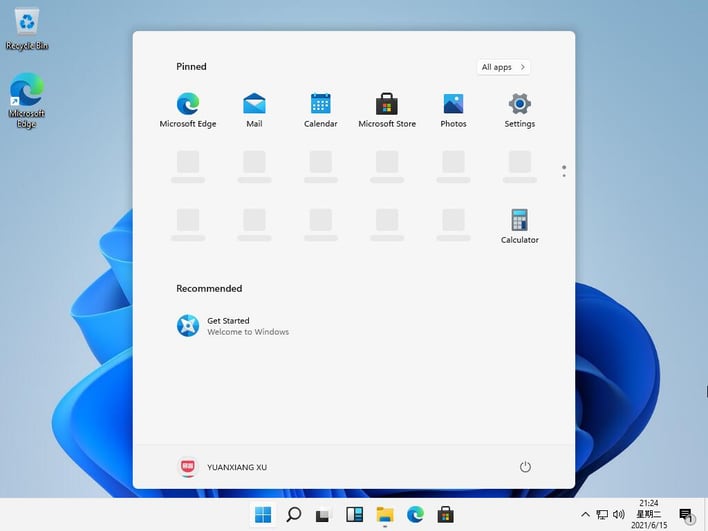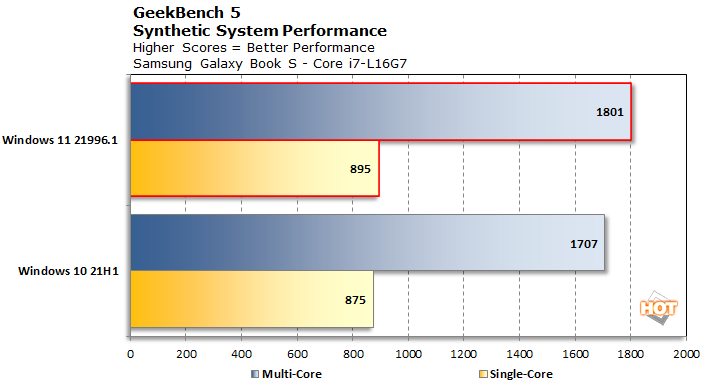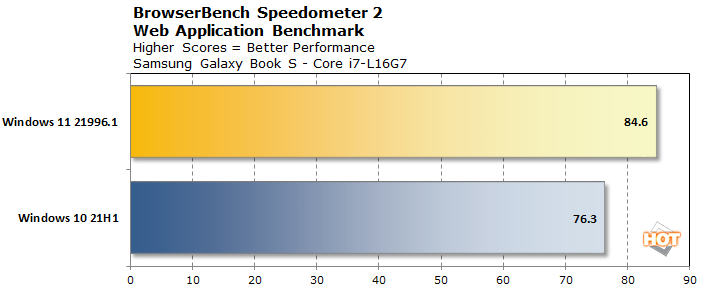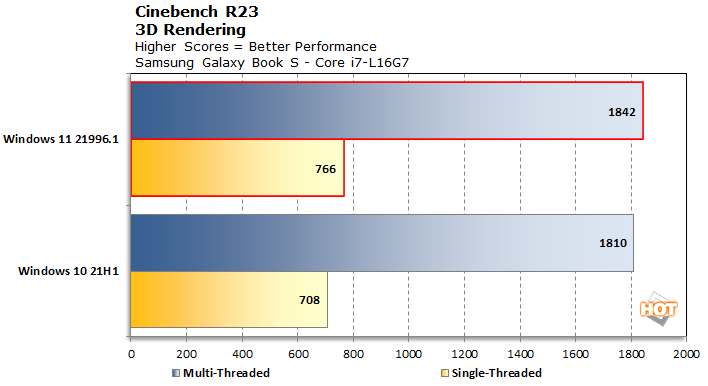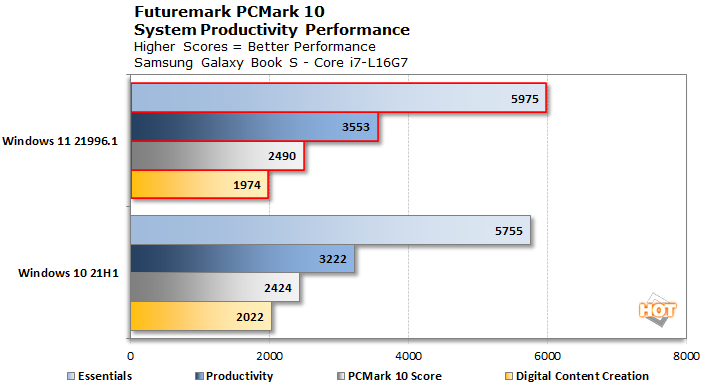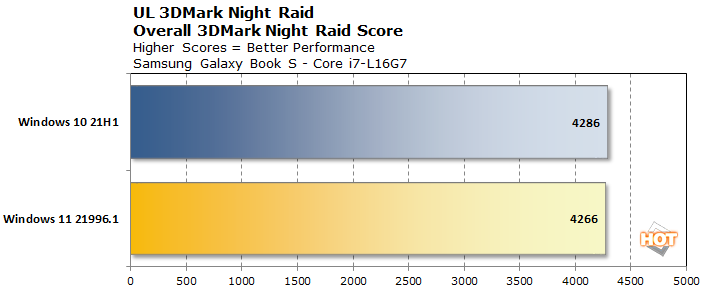Back in September of last year, the x86 version of the Samsung Galaxy Book S failed to wow us with its performance and battery life. This ultralight laptop is powered by Intel's
Lakefield-based Core i5-L16G7 processor, which was the company's first attempt at creating a hybrid processor with a big.Little architecture consisting of performance and efficiency cores. Back then, we
discovered that the Arm64 version of this machine, with a Qualcomm Snapdragon 8cx under its hood, was both faster and longer-lasting on its battery. At the time we wondered if the x86 version of Windows really knew the difference between the Tremont-based efficiency cores and the lone performance core on board Lakefield. Fast forward nine months, and a leaked ISO for a
preview version of Windows 11 gives us cause to revisit this machine to see what's changed, if anything with Microsoft's scheduler that theoretically should be more optimized for hybrid architectures.
This isn't a full performance review of course, but more of a preview. Obviously
Windows 11 won't even be official until Microsoft's June 24 announcement, and in its current state it's a very early preview at best. Still, it seems usable enough and manages to run with all of the same drivers of Windows 10 21H1, so we figured we'd look into how the performance compares. We've already taken a quick peek at Windows 11 on more mainstream notebooks and came away mildly impressed that performance didn't fall off a cliff at this early stage. Due to Microsoft's previous announcement that Windows 10X features would be
rolled into mainline Windows, we figure the two operating systems share more than a few lines of code.
Testing Windows 11 On Intel's big.Little Lakefield
To test this low-powered Lakefield machine, we first fully updated it to Windows 10 21H1, which was just released about a month ago, and ran several of our usual performance tests a minimum of three times. The median is what we report, just like always. Then we installed Windows 11 from a USB drive and re-ran all of our tests, again reporting the median. We used Samsung's updater to keep all of the base drivers fresh on both operating systems. Without further ado, let's take a peek.
 |
|
Geekbench 5 |
| Synthetic System Performance |
|
Before we get to the more real-world stuff, let's take a look at the latest version of Geekbench 5.
We're off to an interesting start, as just switching operating systems gave us around a 5.8% boost in the multi-threaded version of this benchmark. The single-threaded test, which presumably runs mostly on the single high-performance core, doesn't gain much, just a bit shy of 2%. While it's not exciting, it may lay the foundation for what we hope to see in the rest of these tests.
 |
| Browserbench Speedometer 2.0 |
| Web Application Performance |
|
Our favored web benchmark runs a series of sample projects written in real-world JavaScript frameworks like Angular and React in the browser and measures how many of them it can run per minute, excluding download times. The higher the number, the better.
We saw something along these lines
in our previous tests with Windows 11, and we wondered if maybe the different timeframes at which the systems were tested resulted in skewed scores because of different versions of Chrome. We avoided that here, because we re-tested everything in Windows 10 21H1 prior to upgrading to Win 11. For whatever reason, Windows 11 just runs Chrome v91 -- or at least this benchmark -- more than 10% faster than Windows 10 21H1. This was repeatable across all of our runs, so it's unlikely to be a fluke. We have theories in our noggins regarding this observation, but let's look at all the data first.
 |
|
Cinebench R23 |
| Rendering Performance |
|
While it's unlikely that one would buy a very thin-and-light notebook to do heavy-duty rendering, Cinebench gives us a nice all-core stress test to see how the system handles a sustained load.
If two times is a coincidence, is three times a trend? Three tests, and in each one, the
Samsung Galaxy Book S and its Core i5-L16G7 has been faster across the board in Windows 11. This time, the bigger gains are found in the single-threaded test, and to the tune of around 8.2%. Could there really be something to this? It's time to run a few more real-world application benchmarks. Let's move on to PCMark 10.
 |
|
UL PCMark 10 |
|
System Application Performance |
|
PCMark 10 is a pretty strenuous test that measures performance in all kinds of real-world settings, including video conferencing, word processing, video and image editing, and spreadsheets. Let's see how it went.
Well, that was unexpected. We'd figured to see at least a little tip in Digital Content Creation, with Windows 11 running drivers meant for an older operating system. And that's exactly what we got, but the gains across the Productivity and Essentials workloads were enough to steer the very early release of Windows 11 to a slim, overall win. We did not see this one coming. We're talking about less than three percentage points, but a win is a win we suppose.
 |
| 3DMark Night Raid |
|
3D Application Performance |
|
This is one test where we figure Windows 11 will fall down. 3DMark relies heavily on drivers, and the drivers on the Galaxy Book S are not meant for this operating system. Still, it ran and completed the test on its integrated Intel UHD Graphics without any noticeable issues.
Just like the Digital Content Creation test, Windows 11 can't quite keep up with Windows 10. It's awfully close, and at less than one percentage point we're inclined to call this one a draw.
Windows 11 On Intel Lakefield Conclusions
While the inner machinations of Windows are an enigma for most people, we have a theory as to what's going on here in our test results. Our working theory is that Microsoft has put in a lot of work for Lakefield, perhaps in anticipation of Intel's Alder Lake, with respect to the Windows scheduler. Remember that the Core i5-L16G7 represents Intel's first crack at focused cores for performance and power efficiency. Up until then, such things only existed on Arm64. With
Alder Lake set to launch later this year, we think that the Galaxy Book S is perhaps an early benefactor of efforts to ensure that Intel's new hybrid architecture lives up to its full potential.
These efforts might also make their way into an upcoming Windows 10 update, but until Microsoft lays out its plans for its current OS for the rest of the year, it's hard to say. With Windows 11
being a free upgrade, we don't expect 10 to see too many huge feature releases soon, though. What we do know is that the current shipping version of Windows trails by a small but repeatable margin to a preview version of the upcoming Windows 11, at least on Intel's Lakefield. As we said before, we're cautiously optimistic about the latest version of Windows, and we'll continue to track its progress.
